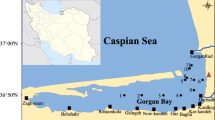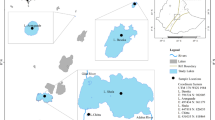Abstract
The purpose of this study was to examine the spatial and temporal variations of phytoplankton species composition and biomass in Lake Bunyonyi, South-Western Uganda. Samples were collected monthly from nine fixed stations in the lake from October 2019 to September 2020. Based on the morphological characterization, 52 different species of phytoplankton were recorded. These were dominated by cyanobacteria (21 species) and chlorophytes (15 species) followed by diatoms (10 species), euglenophytes (4 species), dinoflagellates (2 species), and cryptophytes (1 species). The biomass (Chl-a concentration) ranged from 0.019 ± 0.009 mg/L at Heissesero station to 0.045 ± 0.013 mg/L obtained at Nyombe station. On a temporal basis, the highest mean Chl-a concentration of 0.044 ± 0.03 mg/L was recorded in March 2020 while the least concentration of 0.015 ± 0.011 mg/L was obtained in September 2020. Significant differences existed in the Chl-a concentration values between stations and across sampling months. Chl-a concentration was significantly positively correlated with dissolved oxygen (DO), turbidity but negatively correlated with temperature. The Shannon–Wiener index and evenness put it clear that the distribution of phytoplankton species in the lake is inequitable. Besides, 94.2% of the phytoplankton species revealed had never been reported by the previous studies in the study area. The dominance of species cyanobacteria (such as Microcystis spp., Cylindrospermopsis raciborskii, Anabaenopsis sp., and Anabaena sp.) presents potential future challenges to water quality management. Therefore, the establishment of a strong and committed committee dubbed “Lake Bunyonyi Water Management Committee” to oversee the activities and avert potential water quality challenges is strongly recommended. The existence of some toxic phytoplankton species calls for regular monitoring and careful use of the lake and its food products.







Similar content being viewed by others
Data availability
All data generated and analyzed during this study are included in this published article.
Abbreviations
- WHO:
-
World Health Organization
- APHA:
-
American Public Health Association
- NWSC:
-
National Water Sewerage Cooperation
References
APHA. (2005). Standard methods for the examination of water and wastewater. American Public Health Association (APHA).
Babu, J. M., Getabu, A. M., Omondi, R., Njiru, M., Boera, P., Ogendi, G. O., Sitoki, L., & Ojwang, W. (2015). Phytoplankton distribution and abundance in small water bodies of the Lake Victoria Basin of Kenya.
Bano, Z., Chuahan, R., Mehmood, S., & Naik, S. (2017). A study of seasonal physico–chemical parameters in Upper Lake Bhopal. World Journal of Pharmacy and Pharmaceutical Sciences, 6(8), 1728–1736.
Bell, P. R. F. (1992). Eutrophication and coral reefs—Some examples in the Great Barrier Reef lagoon. Water Research, 26(5), 553–568.
Bhushan, R., Bikkina, S., Chatterjee, J., Singh, S. P., Goswami, V., Thomas, L. C., & Sudheer, A. K. (2018). Evidence for enhanced chlorophyll-a levels in the Bay of Bengal during early north-east monsoon. Journal of Oceanography and Marine Science, 9(2), 15–23.
Chen, M., Li, J., Dai, X., Sun, Y., & Chen, F. (2011). Effect of phosphorus and temperature on chlorophyll a contents and cell sizes of Scenedesmus obliquus and Microcystis aeruginosa. Limnology, 12(2), 187–192. https://doi.org/10.1007/s10201-010-0336-y
Dayala, V. T., Salas, P. M., & Sujatha, C. H. (2014). Spatial and seasonal variations of phytoplankton species and their relationship to physicochemical variables in the Cochin estuarine waters, southwest coast of India.
Denny, P. (1972). Lakes of south-western Uganda. Freshwater Biology, 2(2), 143–158. https://doi.org/10.1111/j.1365-2427.1972.tb00367.x
Escalas, A., Catherine, A., Maloufi, S., Cellamare, M., Hamlaoui, S., Yéprémian, C., Louvard, C., Troussellier, M., & Bernard, C. (2019). Drivers and ecological consequences of dominance in periurban phytoplankton communities using networks approaches. Water Research, 163, 114893.
Farouk, A. E., Abdel-Hamid, A. A., & E., & MT, M. (2020). Environmental studies on water quality, plankton and bacterial community in Mariout Lake. Egypt. Egyptian Journal of Aquatic Biology and Fisheries, 24(4), 139–158.
Fonge, B. A., Tabot, P. T., Charleine, D. S., Mambo, F. Q., & Human, L. (2021). Ecophysiological and anthropogenic determinants of phytoplankton community structure in streams receiving effluents from the Douala-Bassa industrial zone. Asian Journal of Environment & Ecology, 24–38.
Harper, D. M., Morrison, E. H., Macharia, M. M., Mavuti, K. M., & Upton, C. (2011). Lake Naivasha, Kenya: Ecology, society and future. Freshwater Reviews, 4(2), 89–114.
Henderson, P. A., & Seaby, R. M. H. (2001). Species diversity and richness 2.65. Pisces Conservation Ltd, Pennington, Lymington.
Heydari, N., Fatemi, S. M. R., Mashinchian, A., Nadushan, R. M., & Raeisi, B. (2018). Seasonal species diversity and abundance of phytoplankton from the southwestern Caspian Sea. International Aquatic Research, 10(4), 375–390.
Iriarte, A., Villate, F., Uriarte, I., Alberdi, L., & Intxausti, L. (2015). Dissolved oxygen in a temperate estuary: The influence of hydro-climatic factors and eutrophication at seasonal and inter-annual time scales. Estuaries and Coasts, 38(3), 1000–1015.
Isles, P. D., Creed, I. F., Jonsson, A., & Bergström, A. -K. (2021). Trade-offs between light and nutrient availability across gradients of dissolved organic carbon lead to spatially and temporally variable responses of lake phytoplankton biomass to browning. Ecosystems, 1–16.
Jiang, M., Zhou, Y., Cao, X., Ji, X., Zhang, W., Huang, W., Zhang, J., & Zheng, Z. (2019). The concentration thresholds establishment of nitrogen and phosphorus considering the effects of extracellular substrate-to-biomass ratio on cyanobacterial growth kinetics. Science of the Total Environment, 662, 307–312.
Kizza, C. L., Tenywa, M. M., Majaliwa, J. G. M., Kansiime, F., Magunda, M., Nakileza, B., Barasa, B., Gabiri, G., Sebuliba, E., & Nampijja, J. (2017). Land use/cover change patterns in highland ecosystems of Lake Bunyonyi Catchment in western Uganda. African Crop Science Journal, 25(1), 43–58.
Li, C., Feng, W., Chen, H., Li, X., Song, F., Guo, W., Giesy, J. P., & Sun, F. (2019). Temporal variation in zooplankton and phytoplankton community species composition and the affecting factors in Lake Taihu—A large freshwater lake in China. Environmental Pollution, 245, 1050–1057.
Lu, J., Zhu, B., Struewing, I., Xu, N., & Duan, S. (2019). Nitrogen–phosphorus-associated metabolic activities during the development of a cyanobacterial bloom revealed by metatranscriptomics. Scientific Reports, 9(1), 1–11.
Lung’Ayia, H. B., M’harzi, A., Tackx, M., Gichuki, J., & Symoens, J. J. (2000). Phytoplankton community structure and environment in the Kenyan waters of Lake Victoria. Freshwater Biology, 43(4), 529–543.
Manning, T., Thilagaraj, A. V., Mouradov, D., Piola, R., Grandison, C., Gordon, M., Shimeta, J., & Mouradov, A. (2021). Diversity of dinoflagellate assemblages in coastal temperate and offshore tropical waters of Australia. BMC Ecology and Evolution, 21(1), 1–14.
Michoacan, P. M. (2008). Mucilage event associated with diatoms and dinoflagellates in Sea of Marmara, Turkey. Harmful Algae News.
Nankabirwa, A., De Crop, W., Van der Meeren, T., Cocquyt, C., Plisnier, P. -D., Balirwa, J., & Verschuren, D. (2019). Phytoplankton communities in the crater lakes of western Uganda, and their indicator species in relation to lake trophic status. Ecological Indicators, 107, 105563. https://doi.org/10.1016/j.ecolind.2019.105563
Ndungu, J., Monger, B. C., Augustijn, D. C., Hulscher, S. J., Kitaka, N., & Mathooko, J. M. (2013). Evaluation of spatio-temporal variations in chlorophyll-a in Lake Naivasha, Kenya: Remote-sensing approach. International Journal of Remote Sensing, 34(22), 8142–8155.
Ngodhe, S. O., Raburu, P. O., Arara, B. K., Orwa, P. O., & Otieno, A. A. (2013). Spatio-temporal variations in phytoplankton community structure in small water bodies within Lake Victoria basin, Kenya. African Journal of Environmental Science and Technology, 7(9), 862–873.
Paerl, H. W., Xu, H., Hall, N. S., Zhu, G., Qin, B., Wu, Y., Rossignol, K. L., Dong, L., McCarthy, M. J., & Joyner, A. R. (2014). Controlling cyanobacterial blooms in hypertrophic Lake Taihu, China: Will nitrogen reductions cause replacement of non-N2 fixing by N2 fixing taxa? PloS One, 9(11), e113123.
Pitcher, G. C., & Jacinto, G. S. (2019). Ocean deoxygenation links to harmful algal blooms.
Qi, Y., Lian, X., Wang, H., Zhang, J., & Yang, R. (2020). Dynamic mechanism between human activities and ecosystem services: A case study of Qinghai lake watershed, China. Ecological Indicators, 117, 106528.
Round, F. E., Crawford, R. M., & Mann, D. G. (1990). Diatoms: Biology and morphology of the genera. Cambridge university press.
Saturday, A., Lyimo, T. J., Machiwa, J., & Pamba, S. (2021). Spatio-temporal variations in physicochemical water quality parameters of Lake Bunyonyi, Southwestern Uganda. SN Applied Sciences, 3(7), 1–14.
Sekadende, B. C., Lyimo, T. J., & Kurmayer, R. (2005). Microcystin production by cyanobacteria in the Mwanza Gulf (Lake Victoria, Tanzania). Hydrobiologia, 543(1), 299–304.
Senar, O. E., Creed, I. F., & Trick, C. G. (2021). Lake browning may fuel phytoplankton biomass and trigger shifts in phytoplankton communities in temperate lakes. Aquatic Sciences, 83(2), 1–15.
Stoof-Leichsenring, K. R., Junginger, A., Olaka, L. A., Tiedemann, R., & Trauth, M. H. (2011). Environmental variability in Lake Naivasha, Kenya, over the last two centuries. Journal of Paleolimnology, 45(3), 353–367.
Talling, J. F., & Driver, D. (1963). Some problems in the estimation of chlorophyll-a in phytoplankton.
Thaipichitburapa, P. (2017). Relationship between dissolved oxygen and chlorophyll a concentrations at Bang Pa Kong Estuary, Thailand. Burapha Science Journal, 22, 238–247.
Tibihika, P. D. M., Okello, W., Barekye, A., Mbabazi, D., Omony, J., & Kiggundu, V. (2016). Status of Kigezi minor lakes: A limnological survey in the lakes of Kisoro, Kabale and Rukungiri districts. Int J Water Resour and Environ Eng, 8(5), 60–73.
Tomas, C. R. (1997). Identifying marine phytoplankton. Elsevier.
van der Merwe, D. (2015). Cyanobacterial (blue-green algae) toxins. In Handbook of toxicology of chemical warfare agents (pp. 421–429). Elsevier.
Wang, C., Wang, L., Deng, D., & Zhou, Z. (2016). Temporal and spatial variations in rotifer correlations with environmental factors in Shengjin Lake. China. Environmental Science and Pollution Research, 23(8), 8076–8084.
WHO. (2015). Management of cyanobacteria in drinking-water supplies: Information for regulators and water suppliers. World Health Organization.
Wilkerson, F. P., Lassiter, A. M., Dugdale, R. C., Marchi, A., & Hogue, V. E. (2006). The phytoplankton bloom response to wind events and upwelled nutrients during the CoOP WEST study. Deep Sea Research Part II: Topical Studies in Oceanography, 53(25–26), 3023–3048.
Worthington, E. B. (1932). A report on the fisheries of Uganda investigated by the Cambridge expedition to the East African lakes, 1930–31 with 3 appendices, 5 maps and 21 other illustrations.
Xu, S., Wang, Y., Huang, B., Wei, Z. -B., Miao, A. -J., & Yang, L. -Y. (2015). Nitrogen and phosphorus limitation of phytoplankton growth in different areas of Lake Taihu. China. Journal of Freshwater Ecology, 30(1), 113–127.
Yang, J., Lv, H., Liu, L., Yu, X., & Chen, H. (2016). Decline in water level boosts cyanobacteria dominance in subtropical reservoirs. Science of the Total Environment, 557, 445–452.
Yang, K., Yu, Z., Luo, Y., Yang, Y., Zhao, L., & Zhou, X. (2018). Spatial and temporal variations in the relationship between lake water surface temperatures and water quality-A case study of Dianchi Lake. Science of the Total Environment, 624, 859–871.
Yu, M., Ashworth, M. P., Hajrah, N. H., Khiyami, M. A., Sabir, M. J., Alhebshi, A. M., Al-Malki, A. L., Sabir, J. S., Theriot, E. C., & Jansen, R. K. (2018). Evolution of the plastid genomes in diatoms. In Advances in botanical research (Vol. 85, pp. 129–155). Elsevier.
Acknowledgements
We would like to thank NWSC, Kampala, Uganda, for accepting us to use their laboratory facilities. We also wish to thank the communities living around Lake Bunyonyi for their support during the study.
Author information
Authors and Affiliations
Contributions
AS conceived and designed the study, collected and analyzed data, and drafted the manuscript. TJL, JM, and SP contributed to the conception and design of the study, assisted in data interpretation and revision of the manuscript for intellectual content. All the authors read and approved the final manuscript for publication.
Corresponding author
Ethics declarations
Ethics approval
Not applicable.
Consent to participate
Not applicable.
Consent for publication
Not applicable.
Competing interests
The authors declare no competing interests.
Additional information
Publisher's Note
Springer Nature remains neutral with regard to jurisdictional claims in published maps and institutional affiliations.
Rights and permissions
About this article
Cite this article
Saturday, A., Lyimo, T.J., Machiwa, J. et al. Spatial and temporal variations of phytoplankton composition and biomass in Lake Bunyonyi, South-Western Uganda. Environ Monit Assess 194, 288 (2022). https://doi.org/10.1007/s10661-022-09954-1
Received:
Accepted:
Published:
DOI: https://doi.org/10.1007/s10661-022-09954-1




